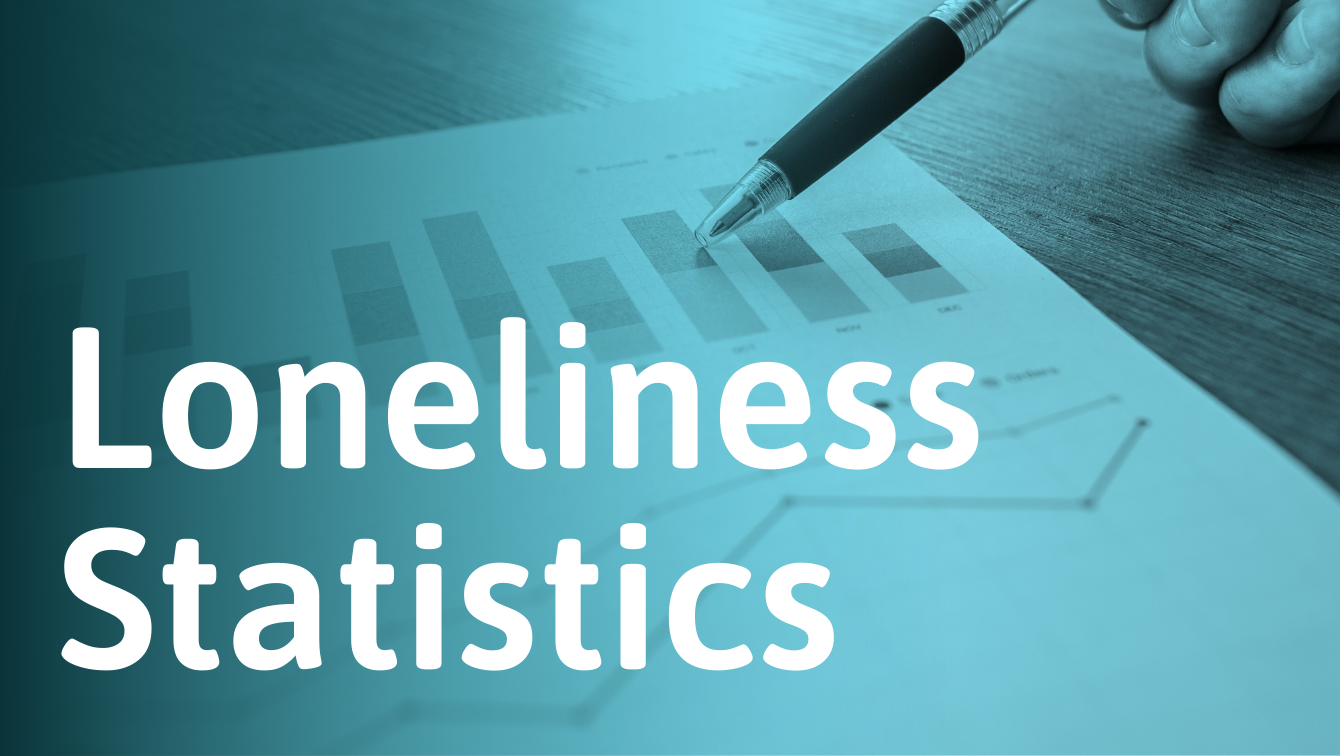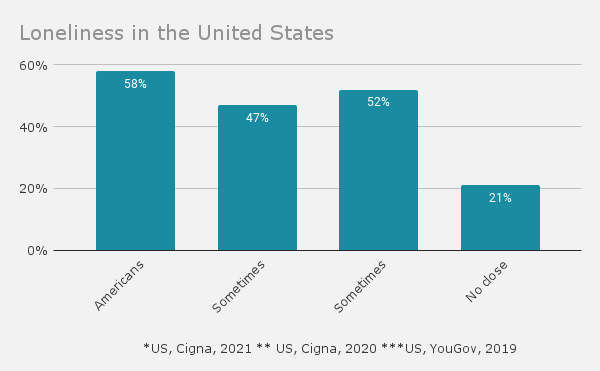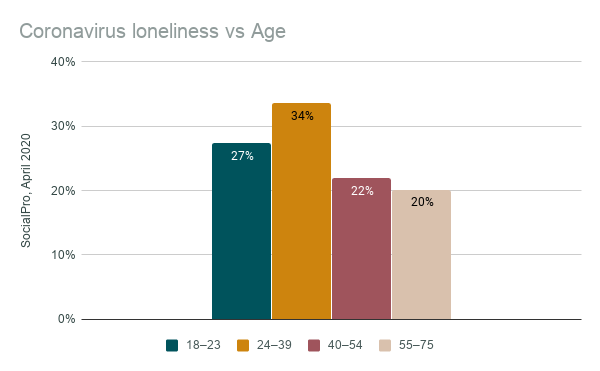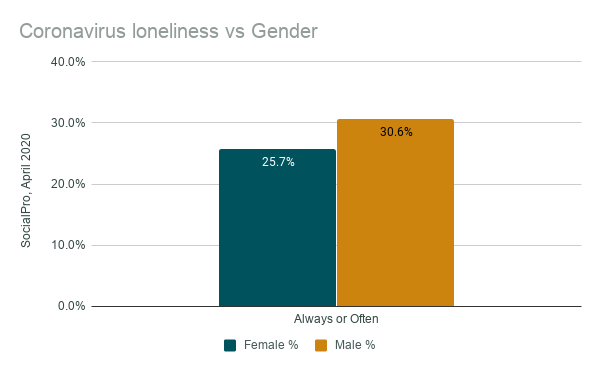Loneliness Statistics 2022: Demographics, USA & Worldwide

![]() Scientifically reviewed by Viktor Sander B.Sc., B.A. on Aug 23, 2022. Last updated Aug 23, 2022
Scientifically reviewed by Viktor Sander B.Sc., B.A. on Aug 23, 2022. Last updated Aug 23, 2022
This report summarizes statistics and data on loneliness and isolation by country, demographics, and life circumstances between 2016-2022. Data sources include OECD, Cigna, YouGov, and The Kaiser Family Foundation.

Sections
- Loneliness in the United States
- Loneliness in the United States compared to other countries
- Loneliness and the Coronavirus / COVID-19 pandemic
- Loneliness and health
- Loneliness in generation Z
- Loneliness among millennials
- Loneliness in generation X
- Loneliness among the elderly
- Loneliness and work
- Loneliness and income
- Loneliness and gender
- Loneliness and race
- Loneliness and education
- Loneliness and social media
- Costs associated with loneliness
Loneliness in the General US Population

- 58% of Americans felt lonely in 2021.[19] (US, Cigna, 2021) That number was 61% in 2019 and 54% in 2018.[1] (US, Cigna, 2020)
- 52% sometimes or always felt alone in 2019. In 2018, that number was 46%.[1] (US, Cigna, 2020)
- 47% sometimes or always felt that their relationships were not meaningful in 2019. In 2018, that number was 43%.[1] (US, Cigna, 2020)
- 21% have no close friends.[2] (US, YouGov, 2019)
- 58% said they sometimes or always felt like no one knew them well in 2019. In 2018, that number was 54%.[1] (US, Cigna, 2020)
- 49% sometimes or always felt as though they lack companionship in 2019. In 2018, that number was 43%.[1] (US, Cigna, 2020)
- 53% say it’s difficult to make friends because they are shy.[2] (US, YouGov, 2019)
Loneliness in the US Compared to Other Countries
OECD, 2020: 9.3% of Americans report not having friends or relatives they can count on. The same number for the UK is 6%, Denmark 4.5%, Iceland 2.4%, Israel 9.4% Greece 21.7%. Mexico 14.9%.[3] (OECD, 2020)
OECD, 2017: 10.1% of Americans report not having friends or relatives they can count on. The same number for the UK is 6.8%, Denmark 4.7%, Iceland 1.7%. Some countries that are more affected: Israel 13.4% Greece 17.7%. Mexico 19.9%.[4] (OECD, 2017)
22% of Americans often or always feel lonely. The same number for the UK is 23% and Japan 9%.[5] (KFF, 2018)
Loneliness and the Coronavirus / COVID-19 Pandemic

- 36% of Americans say they’ve felt more lonely than usual during the pandemic. 50% say there has been no significant impact, and 9% say they’ve felt less lonely than usual.[6] (US, YouGov, 2021)
- 34% of millennials always or often feel more lonely because of the coronavirus situation.[7] (SocialSelf, April 24, 2020)
- 27% percent of Gen Z always or often feel more lonely because of the coronavirus situation.[7] (SocialSelf, April 24, 2020)
- 22% percent of Gen X always or often feel more lonely because of the coronavirus situation.[7] (SocialSelf, April 24, 2020)
- 20% percent of Baby boomers always or often feel more lonely because of the coronavirus situation.[7] (SocialSelf, April 24, 2020)

- 30.6% of men compared to 25.7% of women always or often feel more lonely because of the coronavirus situation.[7] (SocialSelf, April 24, 2020)
Loneliness and Health
- 77% of adults with poor or fair physical health are lonely, compared to 50% of adults with excellent or very good physical health.[19] (Cigna, US, 2021)
- 85% of adults with poor or fair mental health are lonely, compared to 42% of adults who report excellent or very good mental health.[19] (Cigna, US, 2021)
- 26% increase in the likelihood of mortality among individuals who feel lonely.[8] (Social Relationships and Mortality Risk, 2010)
- 45% increased risk of mortality in seniors who are lonely.[9] (US, 2012)
- 29% increased risk of heart disease in individuals with poor social relationships.[10] (UK, 2016)
- 32% increased risk of stroke in individuals with poor social relationships.[10] (UK, 2016)
- Loneliness and isolation have similar effects on health as being obese, an alcoholic, or smoking 15 cigarettes per day.[11] (UK, 2010)
- Loneliness is more harmful than not exercising.[11] (UK, 2010)
Loneliness in Generation Z (Born 1997–2012)
- Gen Z is the loneliest age group.[12] (US, Cigna, 2018)
- 65% sometimes or always feel lonely.[2] (US, YouGov, 2019)
- 69% feel shy.[12] (US, Cigna, 2019)
- 19% have no close friends.[2] (US, YouGov, 2019)
- 87% say it’s difficult to make new friends because they are shy.[2] (US, YouGov, 2019)
Loneliness Among Millennials (Born 1982–1999)
- 65% sometimes or always feel lonely.[2] (US, YouGov, 2019)
- 27% have no close friends.[2] (US, YouGov, 2019)
- 60% say it’s difficult to make new friends because they are shy.[2] (US, YouGov, 2019)
- 42% of millennial women are more afraid of loneliness than a cancer diagnosis.[13] (US, State of Women’s Wellness, 2017)
Loneliness in Generation X (Born 1961–1981)
- 50% sometimes or always feel lonely.[2] (US, YouGov, 2019)
- 33% have no close friends.[2] (US, YouGov, 2019)
Loneliness Among the Elderly
- 44% of Baby Boomers sometimes or always feel lonely.[2] (US, YouGov, 2019)
- 16% of Baby Boomers have no close friends.[2] (US, YouGov, 2019)
- People with a high degree of loneliness are twice as likely to develop Alzheimer’s as people with a low degree of loneliness.[14] (AgeUK, UK, 2014)
Loneliness and Work
Data from Cigna, US, 2021[19]
- Only 47% of lonely employees say they can work efficiently.
- 42% of lonely employees report being “mentally somewhere else” at work.
- 21% of lonely employees are dissatisfied with their jobs, compared to 7% of non-lonely employees.
Data from Cigna Loneliness Index, US, 2020[1]
- 32% of men and 23% of women feel abandoned by coworkers when under pressure.
- 35% feel a general sense of emptiness at work.
- 39% feel like they have to hide their true self at work.
- Lonely workers say they are less engaged, less productive, and report lower retention rates.
- 54% of remote workers feel that their relationships with others are not meaningful. 45% of office-workers feel this way.
- 57% of remote workers say they always or sometimes feel lonely. 52% of office-workers feel this way.
Loneliness and Income
Data from Cigna, US, 2021[19]
- 63% of adults who earn less than $50,000 per year are lonely, compared to 53% of adults earning $50,000 or more.
Data from YouGov Personality Study, US, 2021[6]
- 10% of people making under $40k/year felt lonely most days prior to the pandemic and 5% felt lonely all the time.
- 7% of people making $40-$80k/year felt lonely most days prior to the pandemic and 3% felt lonely all the time.
- 3% of people making $80k+/year felt lonely most days prior to the pandemic and 2% felt lonely all the time.
- 11% of people making under $40k/year reported having no close friends before the pandemic.
- 8% of people making $40-$80k/year reported having no close friends before the pandemic.
- 5% of people making $80k+/year reported having no close friends before the pandemic.
Older statistics for reference
-
- 58% of people making under $40k/year sometimes or always feel lonely.2
- 52% of people making $40-$80k/year sometimes or always feel lonely.2
- 47% of people making $80k+/year sometimes or always feel lonely.2
- 30% of people making under $40k/year have no close friends.2
- 21% of people making $40-$80k/year have no close friends.2
- 11% of people making $80k+/year have no close friends.2
Note that the question used in the survey for the older statistics differ from the question in the newer statistics, so the numbers are not necessarily comparable.
Loneliness and Gender
Data from Cigna, US, 2021[19]
- 59% of women and 57% of men feel lonely.
Data from Cigna Loneliness Index, US, 2020[1]
- 63% of men and 58% of women feel lonely.
Loneliness and Race
Data from Cigna, US, 2021[19]
- 68% of Black/African adults and 75% of Hispanic adults are classified as lonely, significantly higher than the overall population average of 58%.
Data from YouGov Friendship, US, 2019[2]
- 52% of Whites sometimes or always feel lonely.
- 64% of Hispanics sometimes or always feel lonely.
- 47% of Blacks sometimes or always feel lonely.
- 17% of Whites have no close friends.
- 28% of Hispanics have no close friends.
- 37% of Blacks have no close friends.
Loneliness and Education
Data from YouGov Friendship, US, 2019[2]
- 30% of people without high school graduation have no close friends.
- 15% of people with some college education have no close friends.
- 16% of people with a 4-year college education have no close friends.
- 10% of people with a Post Grad have no close friends.
Loneliness and Social Media
- 34% of children aged 12-17 admit to being cyberbullied.[15] (US, 2017)
- 73% of very heavy social media users feel lonely. Compare to light users who feel lonely: 52%.[1] (Cigna, US, 2020)
- When social media is used to enhance existing relationships, it reduces loneliness.[16] (UK, 2017)
- When social media is used to escape social interaction, it increases loneliness.[16] (UK, 2017)
Costs Associated With Loneliness
- $6.7B is the additional US federal healthcare cost related to loneliness among the elderly.[17] (US, 2017)
Loneliness around the world
One survey asked people from around the globe how often they felt lonely.[18] (Ipsos, 2021)
The number of people who said they felt lonely “often, always, or some of the time” varied by country:
- Brazil (50%)
- Turkey (46%)
- India (43%)
- Saudi Arabia (43%)
- Italy (41%)
- South Africa (40%)
- Malaysia (39%)
- Chile (38%)
- South Korea (38%)
- Peru (37%)
- France (36%)
- Argentina (35%)
- Great Britain (34%)
- Mexico (34%)
- Canada (31%)
- United States (31%)
- Australia (30%)
- Singapore (30%)
- Hungary (29%)
- Belgium (28%)
- Spain (27%)
- China (26%)
- Germany (26%)
- Russia (25%)
- Sweden (25%)
- Poland (23%)
- Japan (16%)
- Netherlands (15%)
Overall, 33% of adults across all 29 countries in the survey experience loneliness.
The countries with the highest number of people who declared they “never” or “hardly ever” felt lonely were:
- The Netherlands (55%)
- Germany (50%)
- Russia (49%)